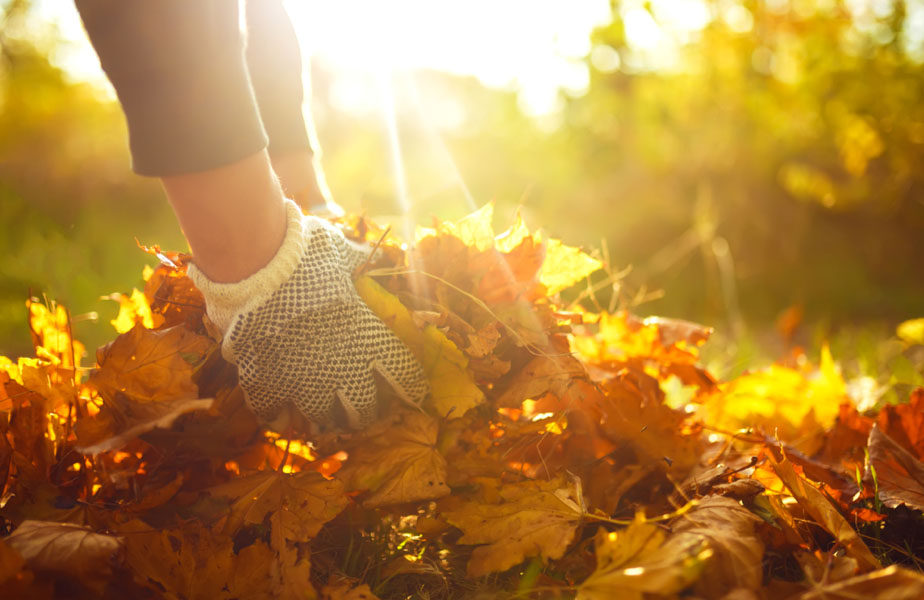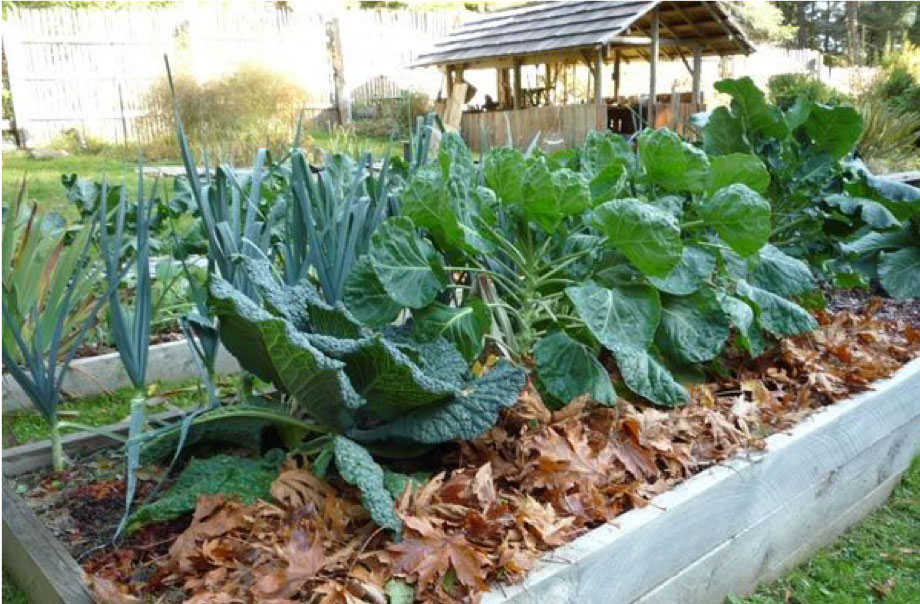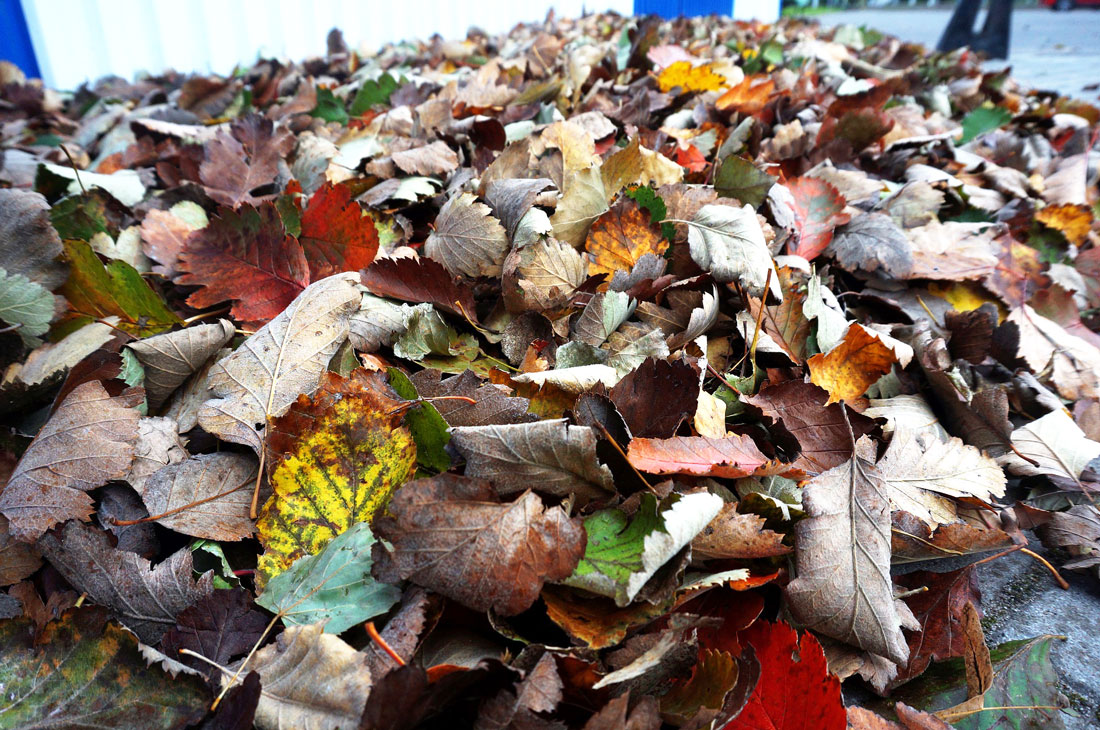
Dear Eartha, the brightly colored autumn leaves are beautiful on the trees, but I know they will soon fall to the ground and the yard work begins. How can I sustainability manage all the leaves in my yard? -Jason, Breckenridge
What an excellent question, Jason! The leaves are changing, and the air is getting cooler, autumn is here in the mountains. Whether you are raking up the fallen leaves or preparing your yard or garden for the winter, don’t toss out your yard waste just yet! Although it may not seem like much to dispose of your yard waste the same way you would household waste – in the trash – it takes a toll on our local landfill and the environment.
According to the Environmental Protection Agency, 33.42 million tons of yard waste were generated in the United States in 2015, equaling 216 pounds per person per year. When we send our leaves to the landfill, they are deprived of the natural elements they need to decompose, produce harmful methane gas, and take up valuable space in our already burdened landfills.
Leaves are truly an invaluable resource! They contain 50 to 80 percent of the nutrients a plant takes in during the summer season and they represent a significant natural resource that can provide a good source of organic matter for your yard and compost. The leaves that accumulate around your yard have so many benefits and should be recycled instead of bagged and thrown away.
 Turning Leaves into Mulch
Mulch, a layer of material applied to the surface of soil, is an effective way to recycle accumulated leaves and improve soil quality. One quick and effective way to manage leaves is to set your lawn mower to the mulch setting and mow the leaves into the grass. This simply shreds the leaves in place on your lawn and creates a nutrient rich mixture that will help feed your lawn in the spring.
Also, you can use a lawn mower with the bag attachment to shred and collect the leaves. Use the leaves as mulch for your vegetable gardens, flower beds, and around trees and shrubs. Mound leaves around tender young plants and shrubs to provide extra winter insulation. This process can significantly help soil quality, prevent soil erosion, and regulate soil temperatures throughout winter.
Drop Off Leaves for Composting
After collecting your leaves, make clean-up well worth it by composting. Composting leaves make a rich, earthy organic matter that can be used to enhance soil quality, retain moisture, and repel weeds. Leaves are rich in trace elements such as calcium, magnesium, potassium, and phosphorous, and when they are collected at their peak and composted, they can transfer this nutrition to the soil.
Turning Leaves into Mulch
Mulch, a layer of material applied to the surface of soil, is an effective way to recycle accumulated leaves and improve soil quality. One quick and effective way to manage leaves is to set your lawn mower to the mulch setting and mow the leaves into the grass. This simply shreds the leaves in place on your lawn and creates a nutrient rich mixture that will help feed your lawn in the spring.
Also, you can use a lawn mower with the bag attachment to shred and collect the leaves. Use the leaves as mulch for your vegetable gardens, flower beds, and around trees and shrubs. Mound leaves around tender young plants and shrubs to provide extra winter insulation. This process can significantly help soil quality, prevent soil erosion, and regulate soil temperatures throughout winter.
Drop Off Leaves for Composting
After collecting your leaves, make clean-up well worth it by composting. Composting leaves make a rich, earthy organic matter that can be used to enhance soil quality, retain moisture, and repel weeds. Leaves are rich in trace elements such as calcium, magnesium, potassium, and phosphorous, and when they are collected at their peak and composted, they can transfer this nutrition to the soil.
 If you like the idea of composting leaves, but do not have the time or space to compost yourself, you can collect and drop off your leaves at the Summit County Resource Allocation Park (SCRAP). When collecting leaves avoid using plastic bags, instead use paper bags or a plastic yard waste container.
You can drop off your leaves for composting Monday through Saturday, 7:00 a.m. to 4:00 p.m. Leaves and yard waste are $31 a ton, with a minimum of $10 per drop-off. When composting leaves, make sure there is no dirt, rocks, bags, weeds, dog waste, or wood in the material.
Other Tips for a Sustainable Fall
After finishing up your sustainable yard clean up, don’t stop there! Keep caring for your community and the environment by also composting your food scraps, weatherizing your home for winter, and supporting local, seasonal produce.
1) The Food Scrap Recycling Program is now free, and it is quick and easy to get started! Enroll now. Free compost buckets are available while supplies last.
2) Winter is quickly approaching; don’t break the bank on high energy bills this year. Through High Country Conservation Center, you can get a home energy audit with recommendations and services that make your home more comfortable and energy efficient.
3) Take advantage of autumn harvests. Seasonal fruits and veggies are fresher, they cut down on food miles, and they support your local economy and community.
Follow these tips and tricks to turn a new leaf and make this beautiful time of year one that is focused on sustainability.
If you like the idea of composting leaves, but do not have the time or space to compost yourself, you can collect and drop off your leaves at the Summit County Resource Allocation Park (SCRAP). When collecting leaves avoid using plastic bags, instead use paper bags or a plastic yard waste container.
You can drop off your leaves for composting Monday through Saturday, 7:00 a.m. to 4:00 p.m. Leaves and yard waste are $31 a ton, with a minimum of $10 per drop-off. When composting leaves, make sure there is no dirt, rocks, bags, weeds, dog waste, or wood in the material.
Other Tips for a Sustainable Fall
After finishing up your sustainable yard clean up, don’t stop there! Keep caring for your community and the environment by also composting your food scraps, weatherizing your home for winter, and supporting local, seasonal produce.
1) The Food Scrap Recycling Program is now free, and it is quick and easy to get started! Enroll now. Free compost buckets are available while supplies last.
2) Winter is quickly approaching; don’t break the bank on high energy bills this year. Through High Country Conservation Center, you can get a home energy audit with recommendations and services that make your home more comfortable and energy efficient.
3) Take advantage of autumn harvests. Seasonal fruits and veggies are fresher, they cut down on food miles, and they support your local economy and community.
Follow these tips and tricks to turn a new leaf and make this beautiful time of year one that is focused on sustainability.
 Turning Leaves into Mulch
Mulch, a layer of material applied to the surface of soil, is an effective way to recycle accumulated leaves and improve soil quality. One quick and effective way to manage leaves is to set your lawn mower to the mulch setting and mow the leaves into the grass. This simply shreds the leaves in place on your lawn and creates a nutrient rich mixture that will help feed your lawn in the spring.
Also, you can use a lawn mower with the bag attachment to shred and collect the leaves. Use the leaves as mulch for your vegetable gardens, flower beds, and around trees and shrubs. Mound leaves around tender young plants and shrubs to provide extra winter insulation. This process can significantly help soil quality, prevent soil erosion, and regulate soil temperatures throughout winter.
Drop Off Leaves for Composting
After collecting your leaves, make clean-up well worth it by composting. Composting leaves make a rich, earthy organic matter that can be used to enhance soil quality, retain moisture, and repel weeds. Leaves are rich in trace elements such as calcium, magnesium, potassium, and phosphorous, and when they are collected at their peak and composted, they can transfer this nutrition to the soil.
Turning Leaves into Mulch
Mulch, a layer of material applied to the surface of soil, is an effective way to recycle accumulated leaves and improve soil quality. One quick and effective way to manage leaves is to set your lawn mower to the mulch setting and mow the leaves into the grass. This simply shreds the leaves in place on your lawn and creates a nutrient rich mixture that will help feed your lawn in the spring.
Also, you can use a lawn mower with the bag attachment to shred and collect the leaves. Use the leaves as mulch for your vegetable gardens, flower beds, and around trees and shrubs. Mound leaves around tender young plants and shrubs to provide extra winter insulation. This process can significantly help soil quality, prevent soil erosion, and regulate soil temperatures throughout winter.
Drop Off Leaves for Composting
After collecting your leaves, make clean-up well worth it by composting. Composting leaves make a rich, earthy organic matter that can be used to enhance soil quality, retain moisture, and repel weeds. Leaves are rich in trace elements such as calcium, magnesium, potassium, and phosphorous, and when they are collected at their peak and composted, they can transfer this nutrition to the soil.
 If you like the idea of composting leaves, but do not have the time or space to compost yourself, you can collect and drop off your leaves at the Summit County Resource Allocation Park (SCRAP). When collecting leaves avoid using plastic bags, instead use paper bags or a plastic yard waste container.
You can drop off your leaves for composting Monday through Saturday, 7:00 a.m. to 4:00 p.m. Leaves and yard waste are $31 a ton, with a minimum of $10 per drop-off. When composting leaves, make sure there is no dirt, rocks, bags, weeds, dog waste, or wood in the material.
Other Tips for a Sustainable Fall
After finishing up your sustainable yard clean up, don’t stop there! Keep caring for your community and the environment by also composting your food scraps, weatherizing your home for winter, and supporting local, seasonal produce.
1) The Food Scrap Recycling Program is now free, and it is quick and easy to get started! Enroll now. Free compost buckets are available while supplies last.
2) Winter is quickly approaching; don’t break the bank on high energy bills this year. Through High Country Conservation Center, you can get a home energy audit with recommendations and services that make your home more comfortable and energy efficient.
3) Take advantage of autumn harvests. Seasonal fruits and veggies are fresher, they cut down on food miles, and they support your local economy and community.
Follow these tips and tricks to turn a new leaf and make this beautiful time of year one that is focused on sustainability.
If you like the idea of composting leaves, but do not have the time or space to compost yourself, you can collect and drop off your leaves at the Summit County Resource Allocation Park (SCRAP). When collecting leaves avoid using plastic bags, instead use paper bags or a plastic yard waste container.
You can drop off your leaves for composting Monday through Saturday, 7:00 a.m. to 4:00 p.m. Leaves and yard waste are $31 a ton, with a minimum of $10 per drop-off. When composting leaves, make sure there is no dirt, rocks, bags, weeds, dog waste, or wood in the material.
Other Tips for a Sustainable Fall
After finishing up your sustainable yard clean up, don’t stop there! Keep caring for your community and the environment by also composting your food scraps, weatherizing your home for winter, and supporting local, seasonal produce.
1) The Food Scrap Recycling Program is now free, and it is quick and easy to get started! Enroll now. Free compost buckets are available while supplies last.
2) Winter is quickly approaching; don’t break the bank on high energy bills this year. Through High Country Conservation Center, you can get a home energy audit with recommendations and services that make your home more comfortable and energy efficient.
3) Take advantage of autumn harvests. Seasonal fruits and veggies are fresher, they cut down on food miles, and they support your local economy and community.
Follow these tips and tricks to turn a new leaf and make this beautiful time of year one that is focused on sustainability.
